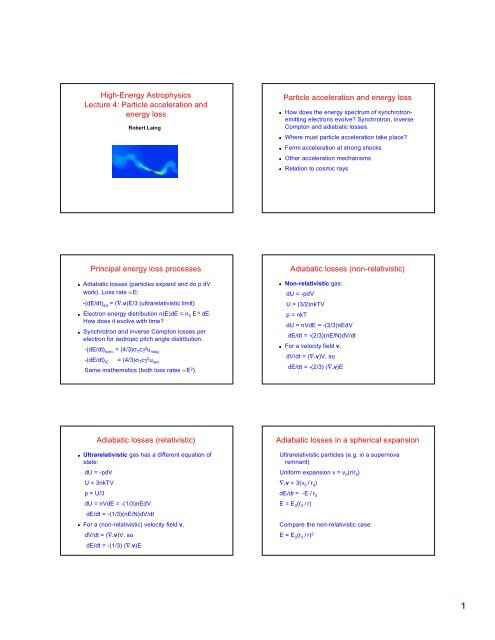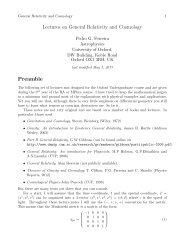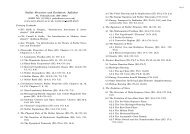High-Energy Astrophysics Lecture 4: Particle acceleration and ...
High-Energy Astrophysics Lecture 4: Particle acceleration and ...
High-Energy Astrophysics Lecture 4: Particle acceleration and ...
You also want an ePaper? Increase the reach of your titles
YUMPU automatically turns print PDFs into web optimized ePapers that Google loves.
<strong>High</strong>-<strong>Energy</strong> <strong>Astrophysics</strong><br />
<strong>Lecture</strong> 4: <strong>Particle</strong> <strong>acceleration</strong> <strong>and</strong><br />
energy loss<br />
Robert Laing<br />
Principal energy loss processes<br />
Adiabatic losses (particles exp<strong>and</strong> <strong>and</strong> do p dV<br />
work). Loss rate ∝E:<br />
-(dE/dt) ad = (∇.v)E/3 (ultrarelativistic limit)<br />
Electron energy distribution n(E)dE = n 0 E -k dE.<br />
How does it evolve with time?<br />
Synchrotron <strong>and</strong> inverse Compton losses per<br />
electron for isotropic pitch angle distribution:<br />
-(dE/dt) sync = (4/3)σTcγ2umag -(dE/dt) iC = (4/3)σ T cγ 2 u rad<br />
Same mathematics (both loss rates ∝E 2 ).<br />
Adiabatic losses (relativistic)<br />
Ultrarelativistic gas has a different equation of<br />
state:<br />
dU = -pdV<br />
U = 3nkTV<br />
p = U/3<br />
dU = nVdE = -(1/3)nEdV<br />
dE/dt = -(1/3)(nE/N)dV/dt<br />
For a (non-relativistic) velocity field v,<br />
dV/dt = (∇.v)V, so<br />
dE/dt = -(1/3) (∇.v)E<br />
<strong>Particle</strong> <strong>acceleration</strong> <strong>and</strong> energy loss<br />
How does the energy spectrum of synchrotronemitting<br />
electrons evolve? Synchrotron, inverse<br />
Compton <strong>and</strong> adiabatic losses.<br />
Where must particle <strong>acceleration</strong> take place?<br />
Fermi <strong>acceleration</strong> at strong shocks<br />
Other <strong>acceleration</strong> mechanisms<br />
Relation to cosmic rays<br />
Adiabatic losses (non-relativistic)<br />
Non-relativistic gas:<br />
dU = -pdV<br />
U = (3/2)nkTV<br />
p = nkT<br />
dU = nVdE = -(2/3)nEdV<br />
dE/dt = -(2/3)(nE/N)dV/dt<br />
For a velocity field v,<br />
dV/dt = (∇.v)V, so<br />
dE/dt = -(2/3) (∇.v)E<br />
Adiabatic losses in a spherical expansion<br />
Ultrarelativistic particles (e.g. in a supernova<br />
remnant)<br />
Uniform expansion v = v0 (r/r0 )<br />
∇.v = 3(v0 / r0 )<br />
dE/dr = -E / r0 E = E0 (r0 / r)<br />
Compare the non-relativistic case:<br />
E = E0 (r0 / r) 2<br />
1
Adiabatic losses: consequences<br />
Adiabatic losses cause rapid dimming of<br />
synchrotron emission as sources exp<strong>and</strong>.<br />
Therefore, bright sources (supernova remnants,<br />
radio galaxies) cannot just be exp<strong>and</strong>ing plasma<br />
clouds: energy must be transported in a loss-free<br />
way to the region where it is dissipated.<br />
Adiabatic losses in a jet - consequences<br />
The surface-brightness (∝jr) is predicted to fall<br />
rapidly with distance. This is not observed.<br />
Either jets decelerate, or particles must be<br />
accelerated, or both.<br />
For a decelerating, relativistic jet, adiabatic losses<br />
only:<br />
j ∝(γβ) -(5α/3 + 2) r -(7α/6 + 3) (Bperp )<br />
j ∝(γβ) -(2α/3 + 1) r -(10α + 9)/3 (Bpar )<br />
Synchrotron <strong>and</strong> inverse Compton<br />
lifetimes<br />
Characteristic lifetime τ = E/(dE/dt)<br />
Synchrotron<br />
τ = E/ (4/3)σTcγ2umag = 3.3 x 107 (B/nT) -3/2 (ν/GHz) -1/2 years<br />
Some examples:<br />
Cygnus A hot-spots, 5GHz: τ ≈ 104 years<br />
M87 knots, X-ray: τ ≈ 10 years<br />
Maximum lifetime for inverse Compton losses<br />
(locally):<br />
τ = E/ (4/3)σTcγ2urad = 2.3 x 1012 / γ years<br />
Adiabatic losses in a jet<br />
Conical jet with constant (non-relativistic) bulk<br />
velocity v:<br />
E-1 dE/dt = -(2/3)v/r<br />
E = E0 (r0 / r) 2/3<br />
<strong>Energy</strong> spectrum evolves:<br />
K0 E -(2α+1)<br />
0 dE0 r 2<br />
0 = K E-(2α+1) dE r2 K = K0 (r / r0 ) -(4α/3 + 2)<br />
Magnetic field B par ∝r -2 or B perp ∝r -1<br />
Emissivity j ∝ KB 1+α ∝r -(7α/6 + 3) = r -3.6 (α = 0.5; B perp )<br />
∝r -(10α+9)/3 = r -4.7 (α = 0.5; B par )<br />
Surface-brightness variation along a jet<br />
Synchrotron radiation losses<br />
Observations<br />
Adiabatic evolution<br />
Brightness decrease<br />
along the jet is far<br />
too rapid<br />
Synchrotron <strong>and</strong> inverse-Compton<br />
losses cause spectral steepening at<br />
high frequencies.<br />
Adiabatic losses cause the spectrum to<br />
shift in the log S - log ν plane<br />
2
M87 jet UV-IR<br />
0.3μm<br />
0.8μm<br />
1.6μm<br />
Optical synchrotron emission from a hotspot<br />
in a powerful radio galaxy<br />
Synchrotron lifetimes: consequences<br />
If τ 10 20 eV<br />
They must function both in the Galaxy <strong>and</strong> in<br />
extragalactic sources.<br />
3
Cosmic-ray energy spectrum Fermi <strong>acceleration</strong> at strong shocks<br />
The best-understood <strong>acceleration</strong> mechanism.<br />
Shocks are formed in:<br />
The inner regions of jets (superluminal<br />
components)<br />
Hot-spots (where jets terminate)<br />
Elsewhere in powerful jets<br />
Supernova remnants<br />
But probably not in low-power, decelerating jets<br />
(which appear to be transonic)<br />
3C279: images Supersonic jet in a radio galaxy<br />
Supersonic jet in a quasar<br />
A shell supernova remnant bounded by a<br />
strong shock<br />
4
Transonic jet in a weak radio galaxy:<br />
X-ray/radio overlay<br />
Fermi <strong>acceleration</strong>: basics<br />
Fundamental idea is that a particle gains energy<br />
when it crosses a shock, <strong>and</strong> that it can be<br />
scattered so that it does so many times.<br />
Consider non-relativistic shocks <strong>and</strong> thermal<br />
plasma (ratio of specific heats = 5/3).<br />
Assume shocks perpendicular to fluid flow.<br />
Material passing through a shock becomes hotter<br />
<strong>and</strong> denser (I.e. KE is converted into internal<br />
energy).<br />
Shock propagates at speed V into stationary fluid<br />
(e.g. ISM around a supernova remnant).<br />
Strong shocks<br />
Assume fluid behaves like a perfect gas in the limit<br />
where the post-shock fluid is much hotter than the<br />
pre-shock fluid (a strong shock). Then the ratio of<br />
the pre- <strong>and</strong> post-shock velocities is:<br />
v2 /v1 = (γH - 1)/ (γH + 1) = 1/4 for a non-relativistic<br />
fluid (γH = 5/3). v1 = V in our case.<br />
Transonic jet: radio-X-ray jet spectrum<br />
Shock geometry<br />
In pre- <strong>and</strong> post-shock frames<br />
5
<strong>Energy</strong> gain on shock crossing<br />
<strong>Particle</strong>s in post-shock fluid with velocities v >> V.<br />
A fraction of these can cross back into the preshock<br />
fluid.<br />
<strong>Energy</strong> of one of these particles in the pre-shock<br />
frame is<br />
E’ = γ(E +px V) = E +px Vrel if non-relativistic<br />
where γ is the Lorentz factor, px is the momentum<br />
component normal to the shock <strong>and</strong> Vrel = 3V/4 is<br />
the relative velocity.<br />
Change of particle energy beween rest frames is<br />
ΔE = p Vrel cos θ where θ is the angle w.r.t. shock<br />
normal. ΔE > 0 for particle to cross shock.<br />
Average energy gain<br />
Assume isotropic. Speed ∝cosθ, so probability<br />
distribution of angles for particles crossing the<br />
shock (0 < θ < π/2) is:<br />
<strong>and</strong> average energy gain is<br />
<strong>Energy</strong> spectrum<br />
Number of crossings<br />
Number with energy > E n<br />
Number with energy E n<br />
<strong>Energy</strong> gain on shock crossing - 2<br />
If the particles are already mildly relativistic, E = pc<br />
<strong>and</strong> ΔE/E = V rel cos θ / c.<br />
Key assumption: there is an elastic scattering<br />
process which isotropises the particle<br />
distribution in the pre-shock fluid with no loss of<br />
energy.<br />
Therefore, a fraction of particles can be rescattered<br />
back into the post-shock fluid. Repetition<br />
of this process causes a fraction of particles to<br />
undergo many shock crossings <strong>and</strong> therefore to<br />
attain high energies.<br />
Multiple shock crossings<br />
<strong>Energy</strong> gain for a double crossing is ΔE/E = V/c;<br />
mean particle energy increased by factor β = 1 +<br />
V/c.<br />
Suppose probability of scattering to achieve<br />
another double crossing is p. Then probability of n<br />
crossings is p n , after which energy is increased by a<br />
factor β n .<br />
Start with N 0 particles with energy E 0 . A fraction p n<br />
is accelerated up to at least energy E n = β n E 0 , so<br />
N(> E n ) = N 0 p n .<br />
The scattering probability<br />
Downstream of the shock, fluid moves away from<br />
the shock at speed V/4. Rate of particle loss is<br />
NV/4 (N is the total number density). <strong>Particle</strong> speed<br />
across the shock = vcosθ <strong>and</strong> probabilty distribution<br />
of angles is p(θ) = (1/2)sinθ (isotropy) so the rate at<br />
which particles enter the downstream region is<br />
<strong>and</strong> fraction leaving shock region is<br />
Hence p = 1 - V/c <strong>and</strong> ln p ≈ -V/c<br />
6
Final energy distribution<br />
N(E) ∝ E (-V/c)(c/V)-1 = E -2<br />
This corresponds to the flattest spectrum observed<br />
in optically-thin regions (frequency spectral index α<br />
= 0.5).<br />
Synchrotron <strong>and</strong> inverse Compton losses tend to<br />
steepen the spectrum.<br />
Relativistic shocks (gamma-ray bursts, parsecscale<br />
extragalactic jets; pulsar-driven SNR)<br />
produce N(E) ∝ E -2.1<br />
Limits on the maximum energy<br />
Acceleration timescale < shock lifetime.<br />
Acceleration timescale < synchrotron lifetime τ =<br />
E/(dE/dt)<br />
Scattering mechanism fails at high energies (e.g. if<br />
gyro-radius r G = γmv/eB is bigger than the size of<br />
the <strong>acceleration</strong> region).<br />
Other <strong>acceleration</strong> processes<br />
Direct <strong>acceleration</strong> by coherent electromagnetic<br />
fields. Relevant near rotating compact objects<br />
(certainly pulsars, perhaps black holes).<br />
Stochastic <strong>acceleration</strong> by MHD turbulence.<br />
Relevant in transonic <strong>and</strong> subsonic flows?<br />
The scattering mechanism<br />
Scattering off Alfven waves (plasma sound waves<br />
excited by particles streaming faster than the Alfven<br />
speed - the effective sound speed in a magnetised<br />
plasma).<br />
Tangled magnetic field on either side of the shock<br />
(recall that a tangled, but anisotropic, magnetic field<br />
can still produce high polarization).<br />
Complications<br />
Oblique shocks - essentially the same as<br />
perpendicular ones.<br />
Back-reaction of high-energy particles on the<br />
shock - not yet solved.<br />
Injection - particles have to be at least mildly<br />
relativistic before this mechanism becomes<br />
efficient.<br />
Time-dependence - are the injection <strong>and</strong> escape<br />
rates sufficiently constant?<br />
7





